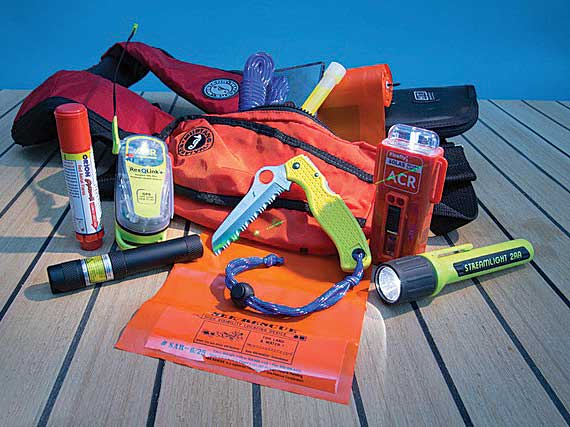
After 30 years of earning paychecks on the water, I’ve realized that Murphy’s law is, well, overly optimistic: If something can go wrong, it will. And when it does, it’s usually at the worst possible moment.
Consider life rafts. By the time we need one, at least two things have gone horribly wrong: the initial calamity and the inadequate tools to resolve it. What Murphy’s law misses, at least on the ocean, is the added likelihood of leaving no survivors to share the cautionary tale, and neglecting life-raft service is like raising your middle finger to Murphy, Neptune, Fate and Mother Nature all at once.
The good news is that advances in materials, packaging and technology have extended service intervals for most life rafts out to three years or longer, instead of the annual recertification common for the rafts we carried just a dozen years ago. While this initially sounds great, it does leave time for unseen problems to take hold, so meeting those required service periods is all that more important. It also requires added diligence by the crew to (hopefully) keep Murphy in his place.
Watch: Take an immersive look at Quepos and the Offshore World Championship.
Materials, Storage, Inflation and Release
While natural-rubber rafts with glued seams are still produced, most life rafts now utilize synthetic materials with welded seams. Both types hold up fine as long as they’re kept dry—catching damage to rafts stored wet is a major justification for annual service. Today, many rafts are vacuum-sealed in bags to mitigate water damage, but that protection comes with a huge caveat, warns Brian Bohne, owner of Inflatable Services in Fort Lauderdale, Florida: “If you’ve got water trapped inside the vacuum bag and it sits there for an extended period, it will eventually ruin the raft.”
Vacuum-sealed bags keep moisture away from metal parts within inflator mechanisms and overpressure relief valves, which also helps extend service intervals. But rapidly expanding carbon dioxide freezes what’s around it, and the volume of CO2 that adequately inflates a raft in cool temperatures will rapidly overinflate it near the equator. This makes timely service for those systems critical. Gauges won’t work on CO2 cylinders either—only verifying adequate weight on a calibrated scale ensures that they’re full. To extend service intervals out to five years, Switlik’s newest rafts inflate with compressed air, mitigating most temperature issues; it also adds a pressure gauge to inspect before each voyage.
On-deck storage is common, but hydrostatic release mechanisms that free rafts from their cradles are a final fail-safe—life rafts are best launched manually before boats sink. Storage locations such as hardtops surrounded by tower pipes or foredecks void of railings aren’t safe on foundering boats, and neither is navigating an engine room or galley on fire to retrieve a raft. A locker near the helm might be a good choice, but be sure to eliminate any protruding screws or sharp fiberglass edges first, and add Dri-Dek tiles to elevate the raft off wet surfaces. It’s also best to avoid small openings—a compromised vacuum bag might let a stored raft expand too large to retrieve from that locker when you need it. “It’s far better to have a more compact life raft you can get to rather than the best raft in the world that burns or sinks with the boat,” Bohne says.
As for rafts packed in soft-sided valises, Bohne says that a quick look inside a Velcro closure shows when a vacuum bag has expanded, either because it was pierced or the inflator cylinder leaked. Both problems require prompt service, and the same holds true for any physical damage to fiberglass canisters that store life rafts on deck. Also, be aware that compact coastal rafts that aren’t vacuum-bagged require annual service and dry storage regardless.
Ancillary Equipment
“Do you let a flashlight sit in your tackle drawer for three years and expect it to work when you need it?” asks Jeff Goodale, owner of Marine Safety Systems in West Palm Beach, Florida. Life-raft equipment has improved significantly, and Switlik’s flashlight, for example, includes leak-resistant batteries that can be recharged by both solar power and a hand crank.
But even if your life raft has extended-service intervals, both Goodale and Bohne suggest assembling a small ditch bag to subsidize it. A working, registered EPIRB—with a backup personal locator beacon in the ditch bag—will almost certainly bring rescue by the US Coast Guard, foreign military or a merchant ship within 24 hours anywhere billfish swim, so it’s possible that survival supplies such as fishing kits and solar stills are practically pointless. On the other hand, Murphy’s law dictates that rafts stored on deck in the tropics for three years will leave flashlights dead, repair-kit cement useless, medication expired, and sunscreen ineffective.
Visit Your Life Raft
Imagine meeting your raft for the first time while swimming in 6-foot seas, in the dark, without your glasses, your eyes burning from diesel fuel, knowing loved ones are also in the water, hopefully nearby. Get to know that raft by making an appointment to visit while it’s being serviced/inflated.
“The captain will probably be handling the emergency, but he could also be injured,” Goodale warns. Owners and frequent guests should know how and when to launch the raft, how to get into it from the water, when to cut it loose from the boat, and how to throw the heaving line to the others who are still swimming. Understand how the overhead canopy and insulated floor inflate, how to douse the sea anchor to drift away from a burning boat, and how to right the raft if it’s upside down.
Read Next: Learn to make full use of a stand-up harness here.
Goodale, whose company maintains all onboard safety equipment—from first-aid kits and defibrillators to fire systems—says that many of his clients service their life rafts more frequently than the specified three-year interval. Unfortunately, a few ignore their rafts. “If you don’t service your safety equipment, it’s not an asset,” Bohne says, “it’s a false sense of security. I would rather know I have nothing than to find the raft I do have doesn’t perform when I need it.”
“You want to minimize your chance of failure,” Goodale adds. “Keep everything up to date and be familiar with your equipment—that way you’re better prepared when Murphy’s law comes calling.”

Ditch-Bag Essentials
- Compensate for extended life-raft service intervals with a ditch bag:
- Registered PLB and waterproof VHF
- Strobe light, signal mirror and other distress signals
- Waterproof flashlight, sharp knife/shears, nylon cord, sponge and no-glue raft-repair clamps
- First-aid kit, motion-sickness medication, drinking water, sunscreen and Mylar blankets
- Bonus items
- Plastic zipper bags, toilet paper and prescription eyewear/reading glasses
- Post-rescue items
- Prescription medications, photocopies of passports, a credit card, cash and a disposable camera
This article originally appeared in the April/May issue of Marlin.







